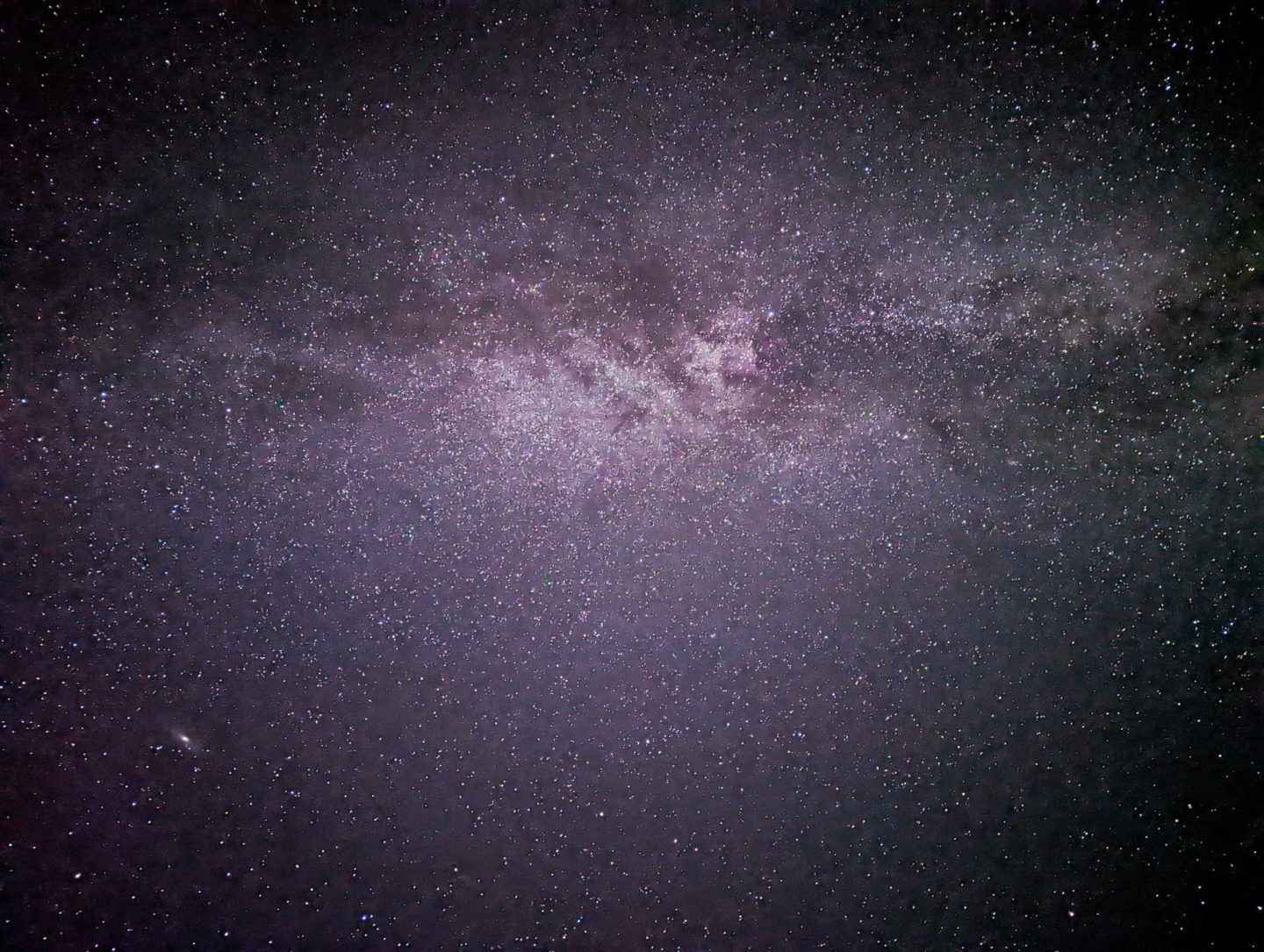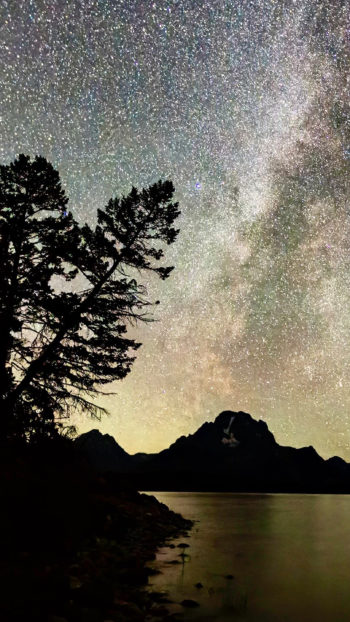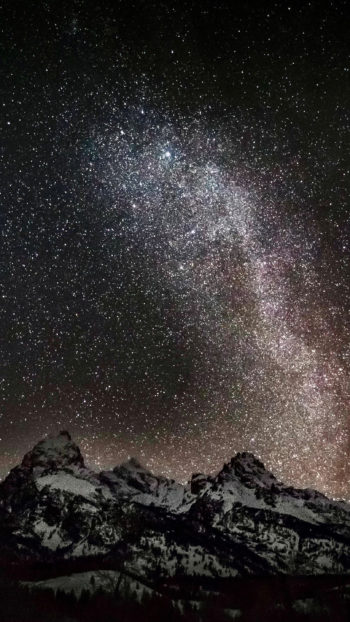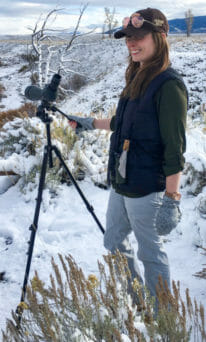Jackson Hole isn’t just a paradise for wildlife enthusiasts—it’s also a premier destination for astrophotographers seeking crystal-clear night skies and stunning celestial views. With minimal light pollution, high elevation, and iconic landscapes like the Tetons as a backdrop, Jackson Hole offers the perfect setting for capturing breathtaking Milky Way shots, meteor showers, and deep-space objects. Whether you’re a beginner looking for basic camera settings or an experienced photographer searching for the best locations, this guide will help you master the art of night sky photography in Jackson Hole.
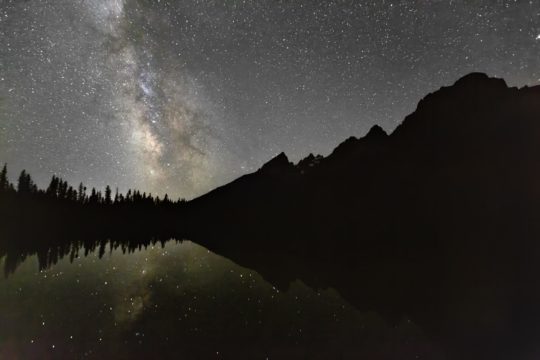
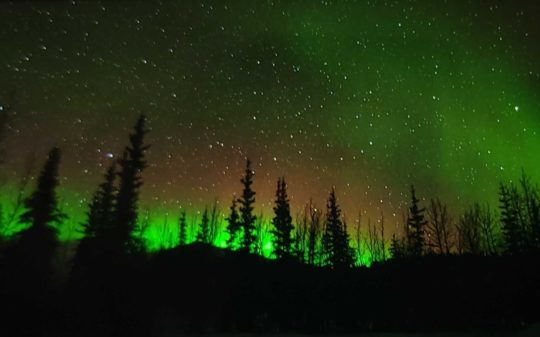
Why Jackson Hole is a Dream Destination for Night Sky Photography
Jackson Hole astrophotography brings night sky viewing to another level. Here’s why this stunning ecosystem is also a premier location for night sky photography:
Minimal Light Pollution for Crystal-Clear Views
Jackson Hole is known for its minimal light pollution, making it an ideal spot for seeing the night sky as you’ve never seen it before. Its remote location, far from city lights, allows for unobstructed stargazing, offering breathtaking visibility of stars, planets, the Milky Way galaxy, and celestial events like meteor showers. The area’s high elevation and dry air further contribute to the clarity of the night sky, providing perfect conditions for both casual stargazers and night sky photographers looking to capture stunning, uninterrupted views of the cosmos.
High Elevation for Stunning Celestial Clarity
With its altitude, the air in Jackson Hole is thinner and drier, which reduces atmospheric interference and provides crisper views of stars, planets, and deep-sky objects. This elevation also minimizes light pollution, further optimizing visibility. The combination of clear skies and high altitude creates the perfect conditions for capturing the night sky in all its glory.
Iconic Landscapes to Frame Your Astrophotography Shots
Jackson Hole offers iconic landscapes that provide the perfect backdrop for astrophotography. The towering Teton Mountains and expansive valleys create dramatic foregrounds, enhancing your night sky shots with stunning natural features. The reflection of the Milky Way in pristine bodies of water like Jenny Lake adds a magical element to your photos, while the rugged terrain of Snake River offers sweeping vistas that frame the stars beautifully. Whether you’re capturing a starry night over the mountains or a meteor shower above the valley, Jackson Hole is no doubt one of the best places for night sky photography in Wyoming.
Essential Gear for Astrophotography in the Tetons
With such a spectacular show in an awe inspiring place like Jackson Hole, you’ll want to make sure that you are prepared with the right gear to get the most out of your excursion. Here are a few things to remember:
Best Cameras and Lenses for Night Sky Photography
A DSLR or mirrorless camera that allows for manual control of exposure, aperture, and ISO is key for shooting in low light. Look for cameras with a high ISO range and good low-light performance. A fast wide-angle lens (f/2.8 or lower) helps capture more light, essential for astrophotography. Lenses between 14mm and 24mm are ideal for capturing expansive views of the night sky and Milky Way.
The Importance of a Tripod and Remote Shutter Release
Long-exposure shots are a must in astrophotography, so a stable tripod is crucial to avoid camera shake. Make sure it’s durable enough to handle outdoor conditions, especially in windy or cold environments. To prevent camera shake during long exposures, use a remote shutter release or set your camera’s timer to avoid touching the camera during shots.
Recommended Apps and Tools for Planning Your Shots
For planning astrophotography shots in the Tetons, PhotoPills, Stellarium, and The Photographer’s Ephemeris (TPE) are essential tools. PhotoPills helps you track the Milky Way, sun and moon positions, and plan star trails with precision. Stellarium simulates what you’d see through a telescope, offering enhanced views of distant stars, galaxies, and nebulae, while TPE maps out the positions of celestial bodies, ensuring you capture the perfect lighting and alignments for your shots. These apps make it easy to plan and capture stunning night sky images.
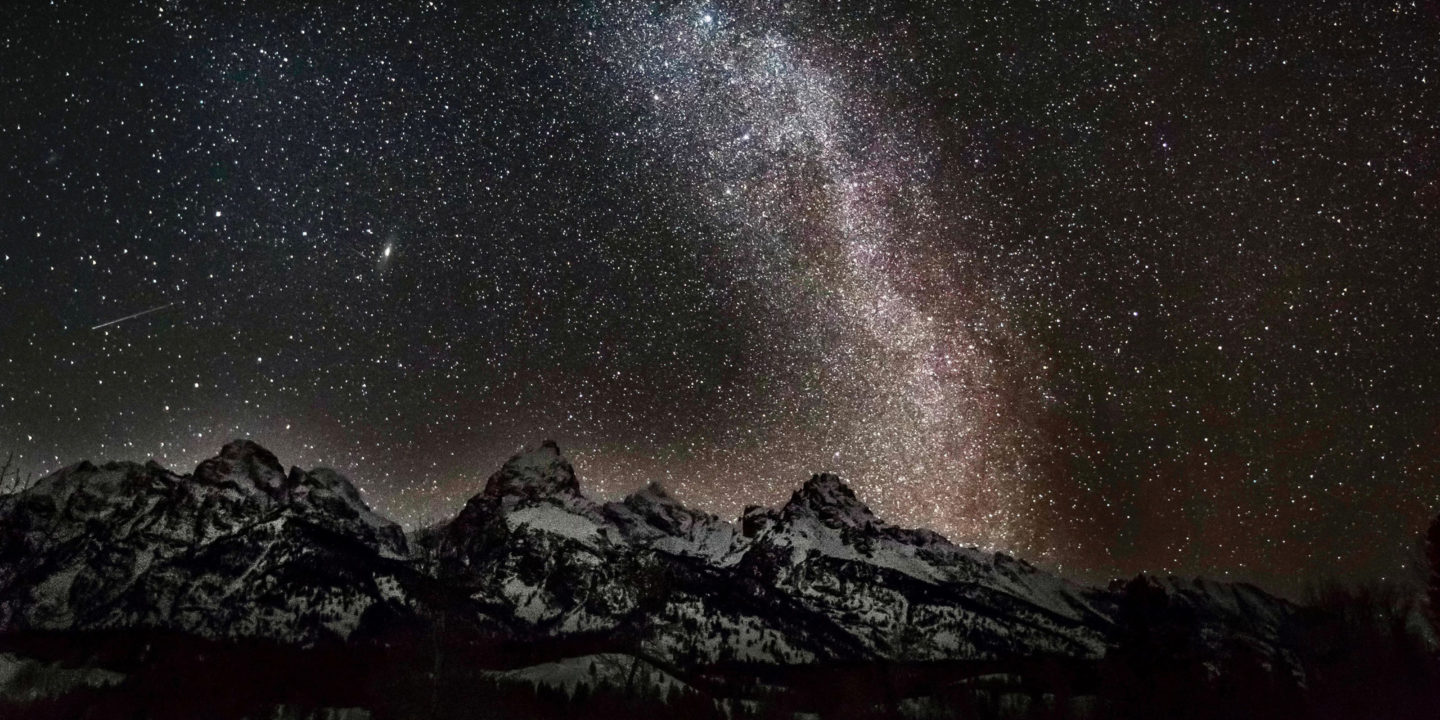
Best Camera Settings for Capturing the Milky Way & Stars
To capture the Milky Way, stars, and planets in the Tetons, adjusting your camera settings for night sky photos is crucial for great results. Here are the best camera settings for astrophotography:
Adjusting ISO, Shutter Speed & Aperture for Perfect Exposure
Set your ISO between 1600 and 3200, depending on your camera’s noise performance. Higher ISOs may capture more stars but can introduce noise. Use a shutter speed of 15 to 30 seconds. To avoid star trails, follow the 500 Rule: divide 500 by your lens’s focal length (e.g., 500 ÷ 24mm = 20 seconds, approximately) for the ideal exposure time. Use a wide aperture (f/2.8 or lower) to allow as much light in as possible for sharp, bright stars. Utilize trial and error to find what works best for your shot; try combinations of ISO and exposure time to capture the best shot!
Using Manual Focus to Avoid Blurry Star Shots
Sharp, pinpoint stars are a must in your night sky photos. To get the perfect focus on distant stars, set your lens to manual focus and zoom in as much as you can on a bright star. Using live view, adjust the focus manually until the star is a single point of light; keep this focus as you zoom back out to capture the landscape.
How to Reduce Noise in Low-Light Photography
Enabling the Long Exposure Noise Reduction (LENR) feature on your camera, which takes a second exposure after your shot to subtract any noise caused by the long exposure, will also help. Always shoot in RAW format, as it retains more detail and gives you more flexibility in post-processing to reduce noise without losing image quality.
Top Locations for Night Photography in Jackson Hole
If you’re looking for the best stargazing photography locations in Jackson Hole, here are a few of the best spots that we recommend:
Grand Teton National Park – The Ultimate Astrophotography Backdrop
With its towering peaks and vast, open landscapes, Grand Teton National Park provides an ideal backdrop to learn how to photograph the Milky Way in Jackson Hole. Locations like Jenny Lake, Oxbow Bend, and Jackson Lake offer breathtaking views of the mountains with the stars above. Signal Mountain delivers panoramic views of the valley and an open view of the sky.
Mormon Row – Historic Barns with a Star-Filled Sky
Mormon Row is a quintessential spot for night photography in Jackson Hole, offering the perfect combination of historic charm and natural beauty. The iconic barns, set against the backdrop of the Grand Teton Mountains, create a striking foreground for capturing the Milky Way or star trails above. The area is relatively remote with minimal light pollution, providing crystal-clear skies ideal for stargazing and astrophotography. The contrast of the rustic, weathered barns with the vast, star-filled sky creates a unique, timeless image, making Mormon Row one of the best locations for capturing both Jackson Hole’s history and its breathtaking night skies.
Shadow Mountain – Panoramic Views with No Light Pollution
Shadow Mountain offers some of the best panoramic views in Jackson Hole, making it a prime location for night photography. With its high elevation, the spot provides sweeping vistas of the surrounding landscape, including the Teton Range and Snake River, all under a vast, star-filled sky.
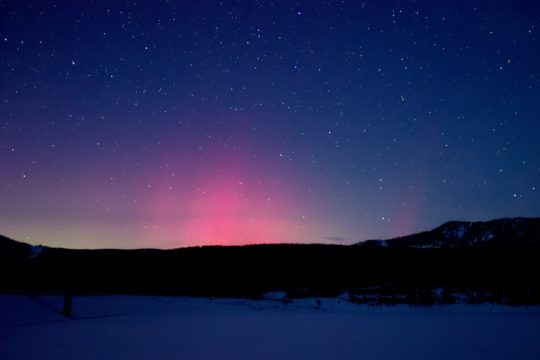
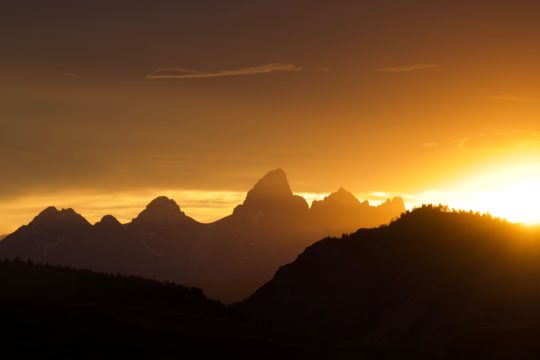
Pro Tips for Taking Astrophotography on a Stargazing Tour
Astrophotography on a stargazing tour is an incredible opportunity to capture the beauty of the night sky in some of the most stunning locations. To help you make the most of your astrophotography experience, here are some pro tips to ensure you capture the night sky in all its glory:
How to Work with a Guide to Find the Best Angles
Guides are familiar with the topography and scenic elements in the area. They can suggest foreground elements, like interesting rock formations, lakes, or trees, that will add depth and context to your images. Guides also often understand how ambient light from nearby areas interacts with the landscape, which can influence your photography. They can point out locations where natural light will illuminate certain features at specific times during the night, allowing you to use light and shadow creatively in your compositions. Your guide is the best resource for the best night sky photo tips in Grand Teton.
Planning Your Visit and Timing Your Shots for Meteor Showers & Planetary Alignments
Timing your shots for meteor showers and planetary alignments is crucial for capturing these celestial events. Use apps like PhotoPills or Stellarium to track peak times and the best viewing locations. For meteor showers, plan for long exposure times (15-30 seconds) and position your camera near the radiant point of the shower. For planetary alignments, research the dates and times of the alignment, and position yourself where the planets will be visible against the night sky. A guide can help with settings, angles, and location, ensuring you capture the event at its peak.
Editing Techniques to Enhance Your Night Sky Images
Editing your night sky images can significantly enhance their impact. Start by using noise reduction tools to clean up high-ISO shots, then boost contrast and clarity to highlight details in both the sky and landscape. Apply sharpening for crisp stars, and if you’ve taken multiple exposures, try image stacking to reduce noise and improve detail. Finally, use gradient filters to balance exposure between the dark sky and the foreground. These techniques will help you create stunning, polished astrophotography images.
Whether you’re experienced with astrophotography or interested in trying it out, our guides offer the best astrophotography tours in Wyoming. You’ll learn so much about your camera, night photography, Jackson Hole, and the celestial world!
FAQs
What is the best time of year for night sky photography in Jackson Hole?
Summer (June–August) is ideal for capturing the Milky Way’s galactic core, while fall (September–November) brings crisp, clear skies with minimal atmospheric distortion. Winter (December–February) offers incredible star clarity and a chance to capture snow-covered landscapes under the night sky, while spring (March–May) provides excellent conditions for potential planetary photography and deep-sky objects.
Do I need professional photography equipment to capture great night sky photos?
No! While DSLR and mirrorless cameras with wide-aperture lenses will yield the best results, you can still take impressive night sky shots with a modern smartphone using long exposure modes and a tripod. For best results, use a manual mode that allows you to adjust shutter speed, ISO, and aperture to optimize light capture.
Are there guided astrophotography tours available in Jackson Hole?
Yes! Jackson Hole Wildlife Safaris offers expert-led stargazing tours that provide guidance on both stargazing and astrophotography. Whether you’re capturing the Milky Way, meteor showers, or distant planets, our guides help you find the best locations and settings for a perfect shot.
What are the best locations in Jackson Hole for astrophotography?
Grand Teton National Park is one of the top spots, offering breathtaking mountain silhouettes under a starry sky. Mormon Row is a favorite for photographers looking to frame historic barns against the Milky Way. For 360-degree dark sky views, Shadow Mountain is a top choice due to its elevation and lack of artificial light pollution.
What settings should I use for night sky photography?
For the best night sky shots, start with these recommended settings:
ISO: 1600–3200 (higher ISO for darker skies)
Aperture: f/2.8 or wider (to capture more light)
Shutter Speed: 10–25 seconds (to prevent star trails)
Focus: Manual mode, set to infinity (∞) for sharp stars
White Balance: 4000K–5000K for natural night tones
Experimenting with these settings and adjusting based on light conditions will help you capture stunning, sharp images of Jackson Hole’s night sky.

